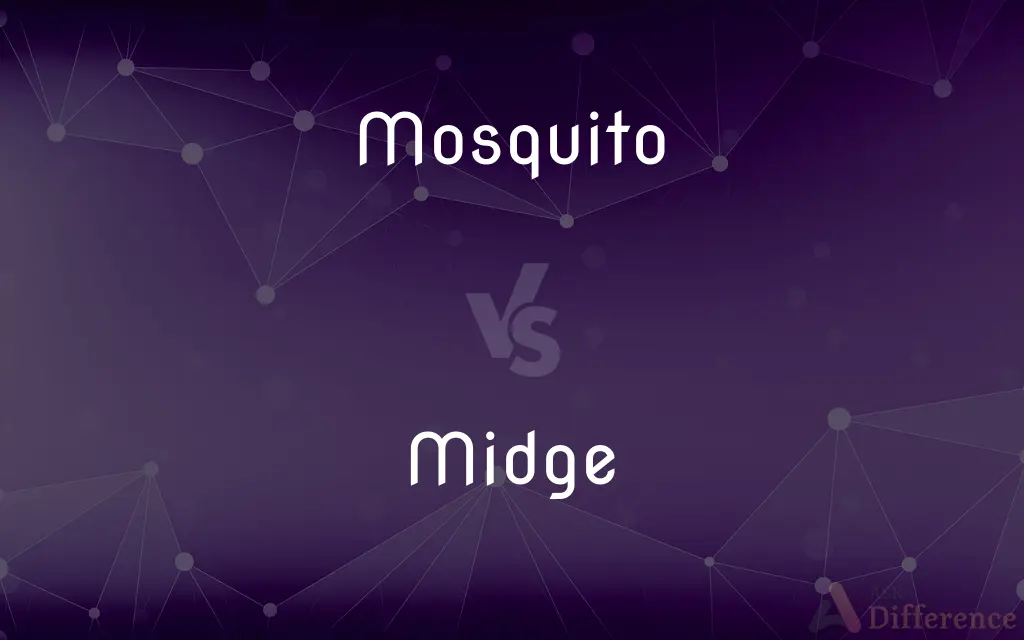Mosquito vs. Midge — What's the Difference?
Edited by Tayyaba Rehman — By Maham Liaqat — Updated on April 5, 2024
Mosquitoes are known for their biting and potential to spread diseases, whereas midges, though similar in appearance, often lack these harmful traits.

Difference Between Mosquito and Midge
Table of Contents
ADVERTISEMENT
Key Differences
The presence of mosquitoes is often associated with stagnant water, where they lay their eggs and the larvae develop. Midges, while also favoring moist environments, can be found in a wider range of habitats, including both freshwater and saltwater. This difference in breeding sites means control measures for each type of insect can vary significantly.
Mosquitoes play a role in the ecosystem as pollinators and as a food source for other wildlife, despite their negative impact on human health. Similarly, midges contribute to their ecosystems, serving as important pollinators and prey for birds, bats, and fish. However, the ecological benefits provided by mosquitoes are often overshadowed by the diseases they can spread.
In terms of nuisance and impact on human activities, mosquitoes are generally considered more problematic due to their biting behavior and the itchy welts they leave behind. While some midge species do bite, many are harmless to humans and are more of an annoyance when they swarm in large numbers rather than a health threat.
Understanding the differences between mosquitoes and midges is important for implementing appropriate pest control strategies and for appreciating their distinct roles within their respective ecosystems. Both insects, despite their similarities, have unique characteristics that define their behavior, habitat preferences, and interactions with humans and the environment.
Comparison Chart
Breeding Sites
Stagnant water.
Freshwater and saltwater, moist environments.
ADVERTISEMENT
Role in Ecosystem
Pollinators, food for other species, disease vectors.
Pollinators, food for other species.
Impact on Humans
Disease transmission, itchy bites.
Annoyance, some species can bite.
Physical Appearance
Elongated body and proboscis.
Shorter mouthpart, varied body shapes.
Compare with Definitions
Mosquito
Control Measures.
Eliminating standing water can reduce mosquito populations.
Midge
Non-Disease Vectors.
Midges are not known to transmit diseases to humans.
Mosquito
Breeds in Stagnant Water.
Mosquito larvae develop in stagnant water sources.
Midge
Varied Feeding Habits.
Most midges do not bite and feed on nectar or other insects.
Mosquito
Disease Vectors.
Mosquitoes can transmit malaria, dengue, and Zika virus.
Midge
Ecosystem Contribution.
Midges serve as food for many birds, bats, and fish.
Mosquito
Ecosystem Role.
Despite their bad reputation, mosquitoes are important pollinators.
Midge
Swarming Behavior.
Midges often form large swarms, especially near water.
Mosquito
Mosquitoes are members of a group of about 3,500 species of small flies within the family Culicidae (from the Latin culex meaning "gnat"). The word "mosquito" (formed by mosca and diminutive -ito) is Spanish for "little fly".
Midge
Breeds in Various Moist Environments.
Midges can be found near both freshwater and saltwater.
Mosquito
See Miskito.
Midge
A midge is any small fly, including species in several families of non-mosquito Nematoceran Diptera. Midges are found (seasonally or otherwise) on practically every land area outside permanently arid deserts and the frigid zones.
Mosquito
To fly close to the ground, seemingly without a course.
Midge
Any of numerous small nonbiting flies of the family Chironomidae, having aquatic larvae and often forming large swarms near ponds and lakes. Also called chironomid.
Midge
Any of various similar dipteran insects, such as the biting midges and the gall midges.
Midge
Any of various small two-winged flies, for example, from the family Chironomidae or non-biting midges, the family Chaoboridae or phantom midges, and the family Ceratopogonidae or biting midges, all belonging to the order Diptera
Midge
(fishing) any bait or lure designed to resemble a midge
Midge
Any one of many small, delicate, long-legged flies of the Chironomus, and allied genera, which do not bite. Their larvæ are usually aquatic.
Midge
A very small fly, abundant in many parts of the United States and Canada, noted for the irritating quality of its bite.
Midge
Minute two-winged mosquito-like fly lacking biting mouthparts; appear in dancing swarms especially near water
Common Curiosities
How can I reduce mosquito populations around my home?
Eliminating standing water sources can significantly reduce mosquito breeding sites.
Do mosquitoes serve any positive role in the ecosystem?
Yes, mosquitoes are pollinators and serve as a food source for various animals.
What causes midges to swarm?
Midges often swarm for mating purposes, especially in moist environments near water.
Why do mosquito bites itch?
Mosquito saliva triggers an immune response that causes itching.
Can midges transmit diseases like mosquitoes?
No, midges are generally not known to transmit diseases to humans.
Are all midges harmless to humans?
While many midge species are harmless, some can bite but are not considered major disease vectors.
Can pest control measures against mosquitoes affect midges?
Yes, since both insects breed in moist environments, control measures can impact both populations.
Are midge bites harmful?
Midge bites can be irritating but are usually not harmful.
Why do mosquitoes need stagnant water?
Mosquitoes lay their eggs in stagnant water, where their larvae can develop safely.
What attracts mosquitoes to humans?
Carbon dioxide, body heat, and certain body odors attract mosquitoes.
How do midges contribute to the ecosystem?
Midges are important as pollinators and as a food source for many predators.
What are some natural predators of mosquitoes and midges?
Birds, bats, fish, and other insects are natural predators of both mosquitoes and midges.
Share Your Discovery

Previous Comparison
Perk vs. Bonus
Next Comparison
Teacher vs. MadamAuthor Spotlight
Written by
Maham LiaqatEdited by
Tayyaba RehmanTayyaba Rehman is a distinguished writer, currently serving as a primary contributor to askdifference.com. As a researcher in semantics and etymology, Tayyaba's passion for the complexity of languages and their distinctions has found a perfect home on the platform. Tayyaba delves into the intricacies of language, distinguishing between commonly confused words and phrases, thereby providing clarity for readers worldwide.















































